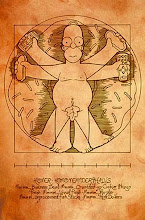1. (Less important) -- I don't find people discussing politics very interesting, for no one changes anyone's mind, they just shout back and forth. Don't believe me? Check out the "Literary" folders (man, they're misnamed!) or many blogs on CSW...

2. (More important) -- I find it reprehensible when teachers of younger students (really all students, but I'd hope that older students wouldn't be as easily influenced) bring their politics into the classroom. I have taught with idiots who do this, and it's just wrong. I have heard kids tell me stories of teachers bashing Clinton and ones bashing Bush. Frankly, that isn't their job, and they're sticking their noses in places that should be reserved for parents. So, if a student of mine stumbles across my blog, I want them to leave here with the same question they leave my classroom with, "Who does Mr. W support politically?" They've never gotten this info from my classroom, and they won't get it from my blog.
Onto last night's game!
Bill Peeck came over last night, and we headed down to the dungeon to give Thirty Years War a shot. We randomly picked sides, and I got the "Catholics" while Bill got the "Protestants." These sides are for game purposes only, as it really wasn't as clear cut as that historically -- a "for instance" is Catholic France fighting on the "Protestant" side. But that really doesn't matter...
We set up the game together so we could get a layout of the board. There are many areas on the board, consisting of several cities each, and they are worth victory points (VPs), varying from 2 to 5. Armies move on the board city to city. Most cities are round spaces which are freely moved through, though there are some fortresses that must be besieged. There are also independent cities worth VPs that aren't part of areas, and "Electorates," both areas and cities, which are worth VPs. During setup, my main forces were in Vienna (Imperial Troops), the Spanish Netherlands, Bavaria, and a small force in Saxony. The Protestant forces were mainly north of the Austrians and Bavarians, with Hungary being in rebellion east of Vienna. Looking over my options, I wanted to end the Hungarian rebellion quickly and than head north with Austrians and Bavarians.
In this game, one gets 7 cards each turn and the cards drive the game. A card can be played for:
1. The event on the card.
2. Foreign Aid listed on the bottom
3. Recruiting of new Mercenary and Militia troops
4. Activation of leaders and their armies
5. As a die roll modifier (drm) in combat (combat cards [CC] only)
In addition, one can decide to not play a card which allows 1 free movement of a troop piece, a leader, or entering into Peace Negotiations (we never tried to Negotiate...)
Events: Each card has an event such as leaders entering, Popes dying, mountain passes being closed/opened, abstracted fighting in the United Provinces (Holland), etc. Playing a card like this puts the event into play.
Foreign Aid (FA): At the end of each turn, armies need to be paid or else they roll on the "Loot" table, raping the countryside! Playing a card for FA puts $$$ in a player's pocket which can be used to pay troops (and prevent pillaging) at the end of a turn. One never seems to have enough money.
Recruiting: Each card has a value of 1, 2, or 3. The number is the number of recruiting tries leaders can make (but no individual leader may make more than 2 per card play). One rolls on the recruiting table for either Mercenary (stronger) or Militia (easier to raise) troops, modifying the roll by the city's pillage level (0 is normal, 1 is moderate pillage, 2 is a city in ruins) and by "dynamic" leaders. Other than a few event cards, this is the only way to get new troops into play!
Activation: Leaders are rated 1-3. A 1 card activates a 1 leader, a 2 card activates a 1 or 2 leader, while a 3 card activates a 1, 2, or 3 leader. Activated leaders can move armies, fight battles, and conduct siege warfare.
Back to the game...
I roll the Austrians into Hungary and they win a battle. The Hungarians retreat and the leader loss rolls (I forgot to mention, leaders die frequently in this game, most have a 20 or 30% chance of dying after any combat!) kill both the Austrian and Hungarian leader. This loses me a good leader, as the replacement is a slug. But it's worse for the Hungarians -- their rebel leader dies, and thus does the rebellion go down in flames. Ouch! I quickly bring Hungary back into the fold and head toward Saxony, to help my hard-pressed allies there. Yes, Bill has been beating on the Saxons quite hard, and taking areas in northern Germany.
Turn 2 and 3 see the Spanish head to the United Provinces (UP) to cause trouble, while a Danish relief force lead by King Christian heads to the UP to bolster the Protestant cause! The north of Germany is siding with the Protestants, while the south is liking the Catholics.
Turns 4-7 see large armies facing off in Saxony while the Catholics manage to capture all Electorates. The tide begins to turn in favor of the Catholics, though French and Swedish entry will soon bolster the Protestant side.
We're having fun, but in a rule look up for something else, we realize we neglected a very important rule. We should have known -- earlier in the game Bill wondered aloud why more of the mapboard wasn't pillaged. It did seem odd, in that troops not paid would do some looting, but all would be "fixed" by the beginning of next turn. Well, the board should have looked worse, a lot worse, for the rule we forgot was:
When moving an army of 3-5 troops, place a Pillage 1 marker in any city along the route; and army of 6+ troops places a Pillage 2 marker or two Pillage 1 markers.
D'oh!!!

We realize that we've completely neglected a key part of the design! Moving around was waaaay too easy. Looting was too easy. We blew it!
So we decided to cut our losses, go back and reread the rulebook, and give it another shot next week. Man, we were just both really getting into the game, and we find out we're misplaying the game, horribly. I admit, I felt pretty stupid...
And that's why my report on the game wasn't very detailed -- we blew it we did. Next time, I promise to get it right.
I hope...



7 comments:
Good overview of the game, Rob.
A long time ago, when I first bought this game, I tried to play a couple of turns with a non-gamer and made some of the same mistakes. Without knowing the history, I couldn't believe there was that much looting and pledging.
I'm still finding this rulebook a bit obtuse for my tastes, but I imagine we'll slog through it and eventually get it right, in spite of our best efforts to the contrary...
Good,
Ron & I now feel better about our Combat Commander games :)
It's a weird feeling when you "know/feel" something isn't right but you don't know what it is.
How about that? All along I thought it was the game that was broken but it's you guys!
Glad you're enjoying it. :)
But, but, but...
Jury's still out on 30YW, but how anyone can play Combat Commander incorrectly, well...
I've never played CC incorrectly, except for a few times that don't count. And those other times, but they don't count either because nobody saw the mistakes.
See? CC can't be played the wrong way!
Post a Comment